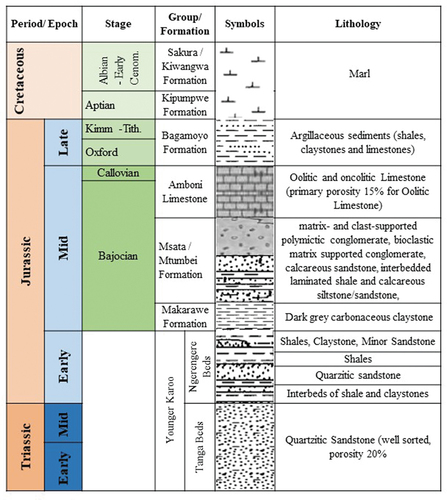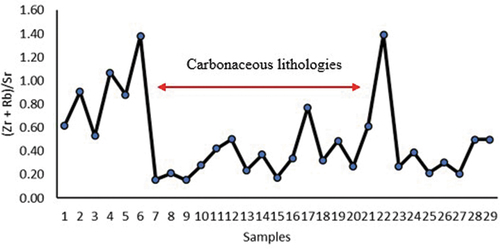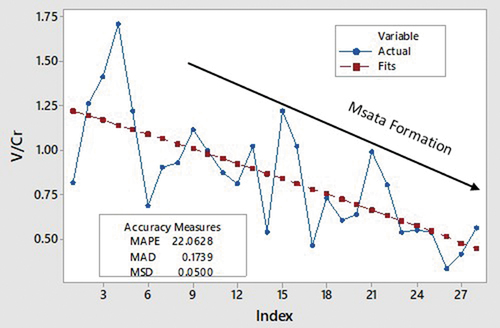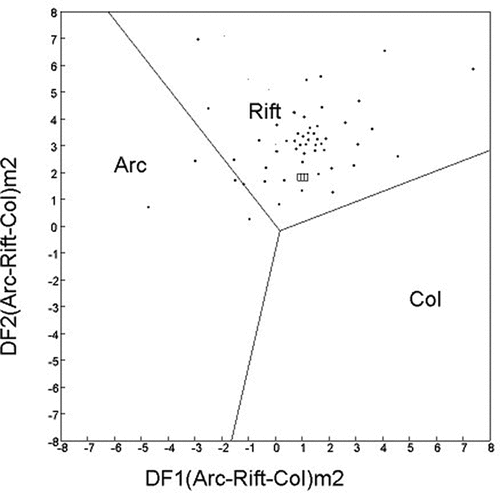ABSTRACT
The paleo-depositional environment of the Ruvu basin ranges from alluvial, floodplain, low- and high-energy fluvial channels, and deltaic sub-environments of Ngerengere beds, Tanga beds, and Jurassic Msata formations. Amboni limestones that overlap the Karoo sequences, Bagamoyo Formation and Sakura Formation were probably deposited in a shallow marine environment. Trace elements show that the sediments were deposited in oxic environments with a V/Cr ratio of 0.85 and Ni/Co ratio of 2.9 to anoxic environments with a V/Cr ratio >4.3. Low Cr, Ni, Co, and V, high Y/Ni and Zr/Cr ratios of up to 0.83 and 3.6, respectively, and low Ti/Zr ratios ranging from 0.004 to 0.01 indicate a contribution from a felsic source, and few ratios >1 show some contribution from a mafic source. This is supported by the diverse enrichment in light rare earth elements (LREEs), small negative Eu anomalies and modest heavy REEs reflecting a dominantly granitic source. The provenance is probably from the Usagaran mobile belt and Proterozoic Mozambique mobile belt. The cross-plot between Th and Ta from mid-Jurassic to Cretaceous sediments indicates that the basin was essentially developed as a passive continental margin; however, discriminant factor plots of the Karoo indicate the existence of a rift setting.
1. Introduction
The Ruvu Basin is a rift basin, formed in the Permo-Triassic to early Jurassic in relating to the break-up of Gondwanaland (Delvaux, Citation2001; Mpanda, Citation1997). The basin is characterized by two major lithological successions; the first succession comprises the siliciclastic sediments, while the second succession composed of chemical to biochemical sedimentary rocks (Kent, Citation1954; Kent et al., Citation1971; Kent & Pyre, Citation1973). Some information has been reported on lithological characteristics of some formations including Karoo Formation (). Detailed interpretation of the sedimentological data obtained from lithological logging of the core/cutting samples and outcrops enable the interpretation of the depositional environments (Li et al., Citation2020), from which the sediments were deposited. To infer the source of sediments that contributed to the siliciclastic lithologies, sediment geochemistry is used as an important tool to pinpoint the source of the sediments (Das & Haake, Citation2003; Moosavirad et al., Citation2011) and the physio-chemical condition of the depositional environments. Also, based on available information, it has not been clearly explained if both lithological successions were deposited in the same tectonic setting; using geochemical plots, it is possible to understand the tectonic setting (Das & Haake, Citation2003; Feng & Kerrich, Citation1990; McLennan & Taylor, Citation1991; Moosavirad et al., Citation2011) that leads to the depositional environments of the two major lithological successions.
Figure 1. Geological map of Ruvu basin (modified after Kent, Citation1954).
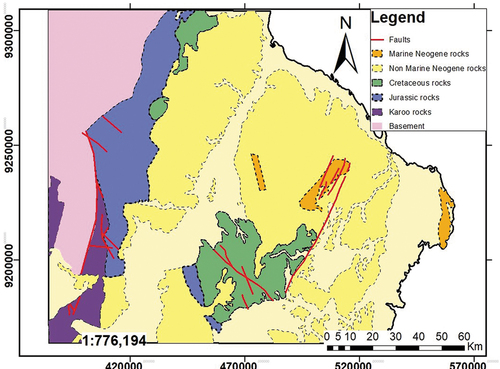
The Ruvu basin structural development and basinal characteristics are very similar to the Gulf of Suez, Benue Trough (Benkhelil, Citation1989; Nwachukwu, Citation1972; Ofoegbu, Citation1984; Olade, Citation1975) and the Viking Graben (Badley et al., Citation1988; Beach et al., Citation1987; Marrett & Allmendinger, Citation1992), for example, all of which are major rift-related hydrocarbon provinces. Despite similarities with rift-related hydrocarbon provinces elsewhere, only two deep wells – Makarawe-1 and Kiwangwa-1 – have been drilled with hydrocarbon shows (Bofin & Pedersen, Citation2017; Kajato, Citation1986; Kidston et al., Citation1997; Komba et al., Citation2015; Zongying et al., Citation2013). Both wells were dry holes, with the presence of hydrocarbon shows at Makarawe-1 (Mahanjane, Citation2014; Mbede, Citation1991; Zongying et al., Citation2013). Being a potential basin for hydrocarbon exploration and a missing link on paleo-physio-chemical environments and tectonic setting, the study focus on interpretation of sedimentological data and geochemical analysis of outcrops, borehole core, and cuttings as an important tool in understanding depositional environment, lithic characteristics of the rocks, physio-chemical condition of the paleo-environment, and tectonic setting, which are important factors during characterization of the source rock, reservoir and seal rock as an important element of the petroleum system.
2. Methodology
Borehole and outcrop logging data were used to synthesize the sedimentological and compositional characteristics. Lithological logs of Makarawe-1 and Kiwangwa-1 boreholes from unpublished drilling reports were used to extract lithic characteristic of the rocks and their stratigraphic relationship. 28 samples collected from different formation along the litho-column were analyzed by X-Ray Fluorescence (XRF). For XRF analyses, 12 g of each milled sample material were mixed with 3 g Lico wax and hard-pressed with the applied pressure of 25 tonne by a hydraulic press to form a powder briquette. The briquettes were analyzed by a PANalytical Magic-X Fast Simultaneous X-Ray Fluorescence spectrometer equipped with Rh-tube. Geochemical data obtained were analyzed using GCDKit 4.2 and TecSand software to infer the tectonic setting of the basin. Th v/s Ta was plotted using GCDKit 4.2, while the arc-rift-collision relationship was plotted using TecSand software based on discriminant Factor 1 and Factor 2 of higher silica. Selection of whether to apply discriminant factors of high silica or low silica approach was assumed based on a sedimentological description of the lithologies, and provenance information was obtained from the analysis of trace and REE elements. This is because some of the major elements results including %SO2 were missing from available data. Also, Min Tab 17 statistical tool was used to analyze the trend of geochemical data.
3. Result and discussion
Description of the lithologies from core/cuttings and outcrops is presented below. During geochemical analysis 20 elements analyzed including Ba, Co, Cr, Rb, Sr, Ta, Ti, Th, Ti, U, V, Y, Zr, La, Pt, Nd, Eu, Yb, La, and Lu and their results are presented in and their corresponding ratios were calculated and are presented in .
Table 1. Trace elements and rare earth elements (REE).
Table 2. Ratios of trace elements and rare earth elements (REE).
3.1. Sedimentological analysis
Based on sedimentological results, six formation were encountered constituting clastic to non-clastic lithologies, these formation include, Sakura (Kiwangwa) formation, Kipatimu (Kipumpwe) formation, Bagamoyo formation, Amboni limestones, Msata formation, and the oldest karoo formation, which overlay on the metamorphic basement of the Mozambique mobile belt.
3.1.1. Sakura formation
This formation has unconformity from 0 to 35 m as observed at Makarawe-1 borehole where Neogene sediments overlay the Cenomanian sediments. From 35 m to 515 m, Marl sequence are medium grey to bluish-grey, soft, sticky, few pyrite cubes seen throughout this section. These marls were probably deposited in shallow shelf environment resulted from Cenomanian transgression (Mweneinda, Citation2014).
3.1.2. Kipatimu formation
Kipatimu formation of Neocomian is estimated to have a thickness of approximately 200 m and is the oldest Cretaceous rocks outcrop exposed 16–19 km west of Chole. They were first described by Stockley (Citation1943) as massive, red and green variegated shales, frequently silty, with occasional cross-bedded friable fine sandstone beds (Mweneinda, Citation2014).
Similarly, to Kipatimu member identified in the northern part of the adjacent Mandawa basin, the Kipatimu formation (Kent et al., Citation1971) at Ruvu basin also constitutes mudstone to silty mudstone whose silt content varies from 0 to 50%, laminated to weakly laminated siltstone containing silt to very fine sand grain sizes and laminated to bedded sandstone whose grain size ranges from fine to very coarse sand with a varying silt content from 0 to 20%. In some locality, across stratified sandy siltstone with their grain size ranging from silt to coarse sand with occasionally mud clasts, often upwards fining sequences. It also has a varying degree of bioturbation, with some shell and coral fragments. The Kipatimu Beds appear to be estuarine brackish-water beds with marine intercalations (Kent et al., Citation1971; Stockley, Citation1943).
3.1.3. Bagamoyo formation
The formation comprises of Argillaceous sediments (shales, claystone, and limestones with minor sandstone) deposited from Aptian to Cenomanian and was penetrated by Makarawe-1 at a depth of 757−1190 m and kiwangwa-1 at 865–2576 m (Mweneinda, Citation2014). Minor outcrops are on the roads between Bagamoyo, Lugoba, and Msata and these exposures are discontinuous, which are sandy limestone, calcareous sandstone with brachiopods, and orbitolina limestone. This formation shows the characteristics of the shallow marine environment, which resulted from late Aptian transgression (Kent et al., Citation1971).
3.1.4. Amboni Limestone
Amboni Limestone is ranging from 80 m to 340 m thick. It is a poorly fossiliferous and dense well-bedded rock with partly oolitic (having a primary porosity 15%) or pisolitic, deposited from Bajocian to Callovian bases on very limited molluscan evidence (Kent et al., Citation1971; Kent & Pyre, Citation1973). Mapping indicates that the Amboni Limestone overlaps the thick Karroo onto Basement. These limestones were possibly deposited in a shallow marine environment (Haldemann, Citation1959). Few shreds of evidence have been reported.
3.1.5. Msata formation
Msata formation is recognized by three major facies associations (Kabohola, Citation2017; Kent et al., Citation1971)) that have been interpreted based ten sub-lithofacies summarized below. The first facies association is characterized by both matrix- and clast-supported inclined polymictic conglomerate and calcareous sandstone, the second facies association containing interbedded laminated shale and calcareous siltstone/sandstone, and the third facies association characterized by bioclastic matrix-supported conglomerate.
Matrix-supported conglomerate ()
Figure 2. Msata formation. a) Matrix-supported conglomerate with clastic, granitic gneiss (black circle), mudstone (black arrow), precipitated calcite (red arrow) and pebble imbrications (black circle). b) Clast supported conglomerate with clastic, granitic gneiss (blue arrows), fossils fragments; brachiopods (black arrows) and gastropods (red arrow). c) Bioclastic matrix-supported conglomerate, it is highly weathered. d) Massive calcareous sandstone; brachiopods fragment (black circle). e) Fossiliferous calcareous sandstone with different fossils fragments like shells of brachiopods, bivalves, and gastropods. f) Planar bedded calcareous sandstone.
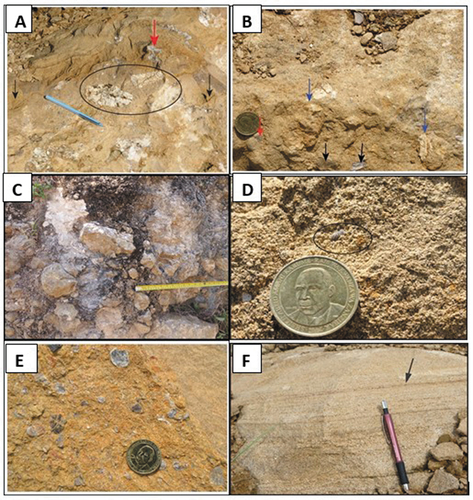
Clast-supported conglomerate ()) have clasts ranging from pebble to boulder size, which is highly indurated, subangular- rounded, limestone, fine-grained sandstone and clasts from the basement (gneiss; Kabohola, Citation2017; Kent, Citation1954; Kent et al., Citation1971). They are massive, tabular to lenticular structure, and sharp surface contact, while their colour ranges from medium-light grey to greyish yellow-green. These conglomerates are characteristic of unidirectional high-energy deposits.
Bioclastic matrix-supported limestone conglomerate ()), these have clasts ranging from pebble to boulder-sized dominated with limestone rip-ups and reworked greenish fine-grained sandstone having a massive, geodes and traces of fossils, and their colour range from medium-light grey to greyish yellow-green. These are likely to be unidirectional high-energy flow deposits.
Massive calcareous sandstone (); Kabohola, Citation2017; Kent et al., Citation1971), these are massive sandstone characterized by medium- to coarse-grained sand, moderately to well sorted and their composition being dominantly quartzo-feldspatho-lithic and cemented with calcite. Their colours are moderate orange pink and are typical of unidirectional medium- to low-energy flow deposit.
Massive fossiliferous calcareous sandstone ()), these massive sandstones characterized by fine to medium-grained sand, sub-angular to sub-rounded, moderate sorted and dominated with quartzo-feldspatho-lithic in their composition. They contain shells of brachiopods, bivalves and gastropod and their colour are moderate orange-pink. They are a typical characteristic of unidirectional medium- to low-energy flow deposit.
Course stratified calcareous sandstone ()) have medium- to coarse-grained sand, moderately sorted and dominantly quartzo-feldspatho-lithic in composition (Kabohola, Citation2017; Kent et al., Citation1971). They are lamination due to change in grain size where sand is interlaminated with thin mica layer, and also they are planar bedded with parting lineation and moderate orange-pink in colour. These sandstones are characteristics of the unidirectional medium- to low-energy flow deposit.
Convolute stratified sandstone ()
Figure 3. Msata formation. (a) convolute calcareous sandstone, (b) calcareous nodules, (c) fine stratified calcareous sandstone, and (d) finely laminated shale (black arrows) interbedded with sandstone/siltstone (red arrows).
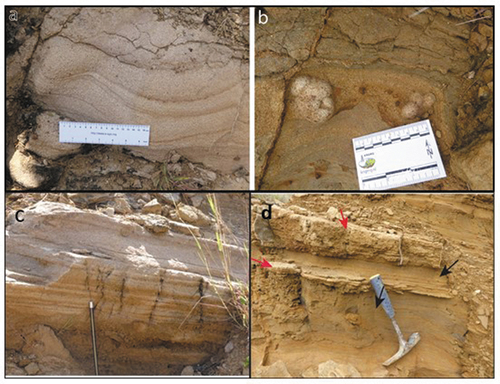
Fine stratified calcareous sandstone ()), these sandstones have medium- to fine-grained sand showing moderately to well-sorted texture. They are planar bedded with parting lineation, a trace of fossils like brachiopods, a trace of plant and have moderate orange-pink colour (Kabohola, Citation2017). They are typical characteristics of the unidirectional medium- to low-energy flow deposit.
Finely laminated shale ()), these are moderately brown finely laminated shales constituting mainly clay to silt size and are characteristic of low-energy depositional environment. The last facies is the Interbedded laminated shale with sandstone/siltstone where the main grain sizes are clay to silt size. They are moderate brown to greyish orange, parallel laminated, weakly laminated and fossils content. These were deposited in a low-energy depositional environment.
The facies associations of Msata formation indicate a deposition environment of sediments in terrestrial settings involving fluvial deposits (alluvial to channel), and marginal marine setting of a deltaic deposit ().
Figure 4. Stratigraphic section of the Msata succession showing features, facies association and depositional environment adapted from Kabohola (Citation2017).
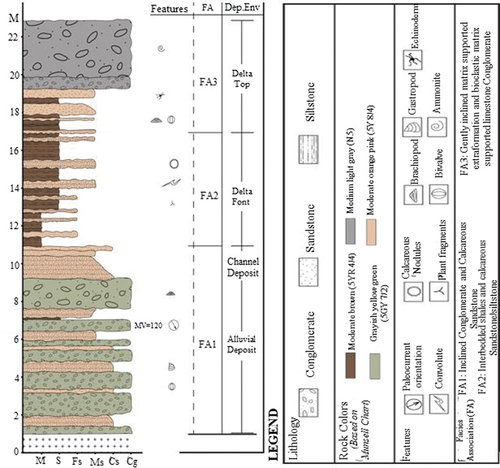
3.1.6. Karoo formation
Deposition of Karoo sequence is related to episodic periods of regional uplift and erosion resulted in the accumulation of over 10,000 m of siliciclastic sediments in the coastal basin including Ruvu basin. In the Ruvu Basin, the Karoo sequence intersected from the drilled wells (Makarawe-1 and Kiwangwa-1 well) includes the older Karoo formation of Permian which also crop out to the south-west of the basin, Tanga beds of Triassic and the lower Jurassic Ngerengere beds which show distinct megacycle of fining upward. The deposition of Karoo lithofacies was controlled by the development of grabens and half-grabens where the main axis of accumulation was probably farther to the east in the graben corresponding to the Ruvu trough. The Karroo sediments are predominantly terrestrial clastics deposited in a variety of continental environments ranging from low-energy fluvial, with lacustrine and deltaic facies, interbedded with occasional marine incursions (Kent, Citation1954; Kreuser, Citation1995; Kreuser et al., Citation1990).
Makarawe-1 well penetrated 2,465 m of the Tanga Beds ranging from clean and sorted, medium- to coarse-grained quartz sandstone with interbedded claystone deposited in a relatively high-energy braided stream environment to coals and carbonaceous shales developed in a floodplain and deltaic environments. Kiwangwa-1 (Haynes et al., Citation1987; SSI, Citation1987) penetrated 352 m of the Tanga Beds comprising interbedded medium- to coarse-grained sandstones and shales.
Ngerengere beds overlay the Tanga beds where it is intersected with Kiwangwa-1 (Haynes et al., Citation1987; SSI, Citation1987) well dominated with well-sorted medium- to coarse-grained quarzitic sandstones interbedded with shales, claystone and dark grey carbonaceous claystone. Ngerengere beds are equivalents to Nondwa formation of Mandawa basin.
In the study conducted by Kent et al. (Citation1971) on outcrop exposures of the coastal basin observed the presence of Karroo facies of bedded feldspathic calcareous sandstone with occasional some oolitic limestone bed and shales near Ngerengere in fault contact with Basement gneisses (Aitken, Citation1959; Hennig, Citation1913). Kent et al. (Citation1971) noted that the lower part of the bedded feldspathic carbonaceous sandstone where a uniform series of cross-bedded feldspathic sandstones which suggests rapid deposition.
3.1.7. Synthesized stratigraphy of the basin
The describe formation above (Aitken, Citation1959; Haldemann, Citation1959; Kabohola, Citation2017; Kent et al., Citation1971; Kent & Pyre, Citation1973; Mweneinda, Citation2014; SSI, Citation1987; Stockley, Citation1943) enabled to synthesize the stratigraphic column of the basin (). However, detailed information form multidisciplinary research such as seismic, petrophysics, sedimentology, geochemistry, geochronology, and sequence stratigraphy will help to generate a general stratigraphy of the basin which is currently Missing.
3.2. Geochemical analysis
The distribution of trace and rare earth element () may give information on provenance, depositional conditions and tectonic setting (McLennan et al., Citation1993). One of the most reliable indicators of sediment provenance is the REE patterns. They are highly resistant to fractionation during weathering and diagenesis and easily preserved in terrigenous sediments (McLennan et al., Citation1993; Mclennan, Citation2018; Taylor & McLennan, Citation1985). Due to nearly quantitative transfer of REE from the source region to the depositional site (largely as suspended rather than dissolved load), the terrigenous sediments should reflect the average composition of the source region (Condie, Citation1993).
3.2.1. Provenance of the sediments
Based on the chondrite, normalized REE patterns of the Kipatimu formation show a diverse enrichment in LREE, small negative Eu-anomalies, modest heavy-REE slop ()
Figure 6. Average chondrite-normalized REE values for the siliciclastic sediments of the Ruvu basin. Chondrite values adapted from McLennan et al. (Citation1980).
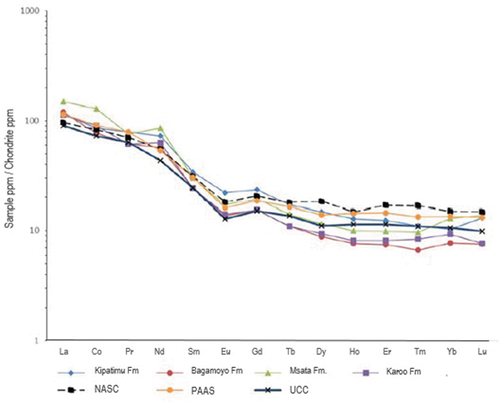
Low concentrations of Cr, Ni, Co, V, and Sc observed in fine-grained sediments reflect sediments were originated from felsic rocks (Condie, Citation1993; Taylor & McLennan, Citation1985).
The Zr/Rb ratios can be used as a tool interpretation of the relative grain size of the siliciclastic sediments, while the disparities in the ratio between siliciclastics and carbonates can be interpreted from (Zr + Rb)/Sr ratios. Higher Zr/Rb ratios averaged 2.7 were encountered in Msata Formation (), which reflect more coarse-grained units, while lower ratios were characteristics of more clayey lithologies of Sakura Formation, Bagamoyo formation, and Makarawe shales. Sr is normally related with carbonates mostly biogenic carbonates. Low (Zr + Rb)/Sr ratios () generally reflect carbonate-rich units (Dypvik & Harris, Citation2001; Taylor & McLennan, Citation1985). The lower Zr/Rb and (Zr + Rb) /Sr ratios of 0.8 and 0.5, respectively, in Sakura, Bagamoyo, and Makarawe formation, suggest more fine-grained and carbonate-enriched sediments, which differ from Msata formation which is characterized by higher Zr/Rb ratios and low (Zr+Rb)/Sr.
Higher Y/Ni, Zr/Cr of up to 0.83 and 3.6, respectively, and lower Ti/Zr ratios ranging from 0.004 to 0.01 generally indicate a contribution from a felsic source supporting the Rare Earth Elements results (Dokuz & Tanyolu, Citation2006; Ishiga et al., Citation1999). But, these ratios can be altered due to weathering in the source and transport of the sediments and diagenesis processes in the depositional environment. The higher Ba/Co ratio of up to 73.21 suggests that sediments derived from a felsic-granitic source (Cullers et al., Citation1988).
3.2.2. Paleo-chemical environment
Also, the ratios of V, Ni, Cr, and Co were used to interpret the redox condition of the paleoenvironment where average V/Cr ratio of 0.85 and Ni/Co ratio of 2.90 were obtained, these values are characteristics of oxic environment and a V/Cr ratio >4.3 has been reported at Makarawe shales indicating Anoxic environmental condition. The trend of V/Cr ratio indicates the more in oxic condition (Chen et al., Citation2019; Jones & Manning, Citation1994; Nagarajan et al., Citation2007) prevailed during deposition of Msata formation whose facies associations belongs to an alluvial, fluvial channel, delta fronts and delta top ().
3.2.3. Tectonic setting
According to Mpanda (Citation1997) and Kapilima (Citation2003), the Ruvu basin is a rift basin, related to the break-up of Gondwanaland in the Permo-Triassic to early Jurassic. The rift formed a north-easterly trend which extended into the offshore zone and developed as a spreading centre (Morley & Ngenoh, Citation1999) which eventually formed the West Somalia Basin leaving the Ruvu Basins as a failed arm forming a half-graben.
Subsequently, from the Mid-Jurassic the Ruvu basin developed essentially as a passive continental margin. The Arc-Rift-Collision discriminant plot (Das & Haake, Citation2003; Moosavirad et al., Citation2011; Roser & Korsch, Citation1986) of the Karoo sandstone (
.) indicated that in a plot of discriminant factor 2 versus Discriminant factor 2 most of the discriminant values falls in a rift setting. From mid-Jurassic to Cretaceous, a plot of Th versus Ta discriminants was plotted (.) and indicates that the values fall into a passive continental margin setting.4. Conclusion
Considering the sedimentological and geochemical aspect, the rocks of the Ruvu basin were deposited in a various depositional environment ranging from deep marine, shallow to fluvial depositional environment. Deltaic environments have been shown in the upper part of Msata formation where the middle and lower show channel and alluvial depositional environment. The Kipatimu formation shows blackish-water estuarine environment with marine intercalations, it also has coal fragments indicating the terrestrial source of the material. Marl of the Sakura formation is related to the transgression event between Albian and Cenomanian that created a shallow marine environment. Other formation includes Amboni limestone which is characterized by oolitic and pisolitic limestones which are inferred to be typical of the shallow marine environment due to the presence of limited molluscan evidence. The Karroo sediments are predominantly terrestrial clastics deposited in a variety of continental environments ranging from low-energy fluvial, with lacustrine and deltaic facies, interbedded with occasional marine incursions.
Based on geochemistry analysis, it shows that the sediments originated from multiple sources ranging from felsic rocks or their equivalent metamorphic rocks most granitic rocks to mafic rocks of either Proterozoic Usagaran mobile belt or Neoproterozoic Mozambique mobile belt. Higher Y/Ni, Zr/Cr, lower Ti/Zr ratios, a diverse enrichment in LREE, small negative Eu-anomalies, and modest heavy-REE possibly reflect a dominantly granitic source. The presence of the clasts of granitic gneiss in matrix and clast supported conglomerates of Msata Formation add to evidence of the contribution of this granitic gneiss as a source of the sediments. Although the high concentrations of Cr, Ni, Co, and V have been reported on some clayey lithologies indicating mafic source, while their ratios indicate that the sediments were deposited in oxic environment especially Msata formation and Blackish water environment for Makarawe shales. According to the tectonic setting discriminant plot, it shows that the basin falls in rift setting, which later were transformed to a passive continental margin setting.
Acknowledgments
The Authors appreciates the support provided by Tanzania Petroleum Corporation (TPDC), Department of Geology of the University of Dodoma and other stakeholders.
Disclosure statement
No potential conflict of interest was reported by the author(s).
References
- Aitken, W. (1959). Quarter degree sheet 55 SW, Kidugallo. Records Geological Survey Tanganyika, 7(2), 1–4.
- Badley, M., Price, J., Dahl, C. R., & Agdestein, T. (1988). The structural evolution of the northern Viking Graben and its bearing upon extensional modes of basin formation. Journal of the Geological Society, 145(3), 455–472. https://doi.org/10.1144/gsjgs.145.3.0455
- Beach, A., Bird, T., & Gibbs, A. (1987). Extensional tectonics and crustal structure: Deep seismic reflection data from the northern North Sea Viking Graben. Geological Society, London, Special Publications, 28(1), 467–476. https://doi.org/10.1144/GSL.SP.1987.028.01.29
- Benkhelil, J. (1989). The origin and evolution of the Cretaceous Benue Trough (Nigeria). Journal of African Earth Sciences (And the Middle East), 8(2–4), 251–282. https://doi.org/10.1016/S0899-5362(89)80028-4
- Bofin, P., & Pedersen, R. H. (2017). Tanzania’s oil and gas contract regime, investments and markets. JSTOR.
- Chen, G., Gang, W., Liu, Y., Wang, N., Jiang, C., & Sun, J. (2019). Organic matter enrichment of the Late Triassic Yanchang formation (Ordos Basin, China) under dysoxic to oxic conditions: Insights from pyrite framboid size distributions. Journal of Asian Earth Sciences, 170, 106–117. https://doi.org/10.1016/j.jseaes.2018.10.027
- Condie, K. C. (1993). Chemical composition and evolution of the upper continental crust: Contrasting results from surface samples and shales. Chemical Geology, 104(1–4), 1–37. https://doi.org/10.1016/0009-2541(93)90140-E
- Cullers, R. L., Basu, A., & Suttner, L. J. (1988). Geochemical signature of provenance in sand-size material in soils and stream sediments near the Tobacco Root batholith, Montana, USA. Chemical Geology, 70(4), 335–348. https://doi.org/10.1016/0009-2541(88)90123-4
- Das, B. K., & Haake, B.-G. (2003). Geochemistry of Rewalsar Lake sediment, Lesser Himalaya, India: Implications for source-area weathering, provenance and tectonic setting. Geosciences Journal, 7(4), 299–312. https://doi.org/10.1007/BF02919560
- Delvaux, D . (2001). Karoo rifting in western Tanzania: Precursor of Gondwana break-up? edited by Klerkx, J. In Contributions to geology and paleontology of Gondwana. In honor of Helmut Wopfner (pp. 111–125). Geological Institute, University of Cologne.
- Dokuz, A., & Tanyolu, E. (2006). Geochemical constraints on the provenance, mineral sorting and subaerial weathering of Lower Jurassic and Upper Cretaceous clastic rocks of the eastern Pontides, Yusufeli (Artvin), NE Turkey. Turkish Journal of Earth Sciences, 15(2), 181–209 https://journals.tubitak.gov.tr/earth/issues/yer-06-15-2/yer-15-2-4-0502-3.pdf.
- Dypvik, H., & Harris, N. B. (2001). Geochemical facies analysis of fine-grained siliciclastics using Th/U, Zr/Rb and (Zr+ Rb)/Sr ratios. Chemical Geology, 181(1–4), 131–146. https://doi.org/10.1016/S0009-2541(01)00278-9
- Feng, R., & Kerrich, R. (1990). Geochemistry of fine-grained clastic sediments in the Archean Abitibi greenstone belt, Canada: Implications for provenance and tectonic setting. Geochimica et Cosmochimica Acta, 54(4), 1061–1081. https://doi.org/10.1016/0016-7037(90)90439-R
- Haldemann, E. G. (1959). Hapurm, J.R and Wright, A.E-A System of Abbreviations used in Reporting Petrographic Data. Hapum, J.R - A Note on the Petrology of the Kidugallo Oolitic Limestone. Macleod, D.A - Mineralogical notes. Records of the Geological Survey of Tanganyika (Dodoma, Tanzania: Geological Society of Tanganyika).
- Haynes, R. C. C., E., M. K., Bate, R. H., Taylor, W., & Trice, R. C. (1987). Stratigraphy of the Kiwangwa-1 well, Tanzania (Report exploration). Tanzania Petroleum Development Corporation (TPDC).
- Hennig, E. (1913). Beiträge zur Geologie und Stratigraphie Deutsch-Ostafrikas. R. Friedlaender.
- Ishiga, H., Dozen, K., & Sampei, Y. (1999). Geochemical constraints on marine invasion and provenance change related to the opening of the Japan Sea: An example from the Lower Miocene shales in the Hoda section, Shimane Peninsula, SW Japan. Journal of Asian Earth Sciences, 17(4), 443–457. https://doi.org/10.1016/S1367-9120(99)00011-5
- Jones, B., & Manning, D. A. (1994). Comparison of geochemical indices used for the interpretation of palaeoredox conditions in ancient mudstones. Chemical Geology, 111(1–4), 111–129. https://doi.org/10.1016/0009-2541(94)90085-X
- Kabohola, J. (2017). Sedimentology and diagenesis of the middle Jurassic Msata succession, Ruvu Basin, Tanzania [BSc. in Geology Master Thesis]. University of Dar es salaam. http://41.86.178.5:8080/xmlui/handle/123456789/10841
- Kajato, H. (1986). The geology and hydrocarbon potential of Tanzania [Paper presented]. The Proceedings, Oil and Gas Exploration in the SADCC region, SADCC Energy Sector Seminar, Arusha, Tanzania.
- Kapilima, S. (2003). Tectonic and sedimentary evolution of the coastal basin of Tanzania during the Mesozoic times. Tanzania Journal of Science, 29(1), 1–16. https://www.ajol.info/index.php/tjs/article/view/18362/17300
- Kent, P. E. (1954). Jurassic and Cretaceous rocks of the Bagamoyo District (D’Arcy Exploration Company Report Geology). Tanzania Petroleum Development Corporation (TPDC).
- Kent, P. E., Hunt, J. A., & Johnstone, D. W. (1971). Geology and geophysics of coastal sedimentary basins of Tanzania. Geophysical paper. Natural Environment Research Council, Tanzania, Institute of Geological Sciences.
- Kent, P. E., & Pyre, J. T. O. (1973). The development of the Indian Ocean margin in Tanzania. Sedimentary Basins of the African Coasts, Part, 2, 113e131.
- Kidston, A. G. I., Mliga, J. R. N., & Kilembe, E. A. (1997). East African regional hydrocarbon study, Tanzania.In The hydrocarbon potential of Tanzania. Tanzania Petroleum Development Corporation (pp. 346–419).
- Komba, K., Rutta, I., & Nyalusi, S. (2015). Keynote presentation: On-shore and off-shore exploration history and discoveries to date in Tanzania [Paper presented]. The First EAGE Eastern Africa Petroleum Geoscience Forum 17-19 November 2015 (European Association of Geoscientists & Engineers) Dar es Salaam, Tanzania.https://doi.org/10.3997/2214-4609.201414435
- Kreuser, T., Wopfner, H., Kaaya, C., Markwort, S., Semkiwa, P., & Aslandis, P. (1990). Depositional evolution of Permo-Triassic Karoo basins in Tanzania with reference to their economic potential. Journal of African Earth Sciences (And the Middle East), 10(1–2), 151–167. https://doi.org/10.1016/0899-5362(90)90052-G
- Kreuser, T. (1995). Rift to drift evolution in Permian-Jurassic basins of East Africa. Geological Society, London, Special Publications, 80(1), 297–315. https://doi.org/10.1144/GSL.SP.1995.080.01.14
- Li, Q., Wu, S., Xia, D., You, X., Zhang, H., & Lu, H. (2020). Major and trace element geochemistry of the lacustrine organic-rich shales from the Upper Triassic Chang 7 Member in the southwestern Ordos Basin, China: Implications for paleoenvironment and organic matter accumulation. Marine and Petroleum Geology, 111, 852–867. https://doi.org/10.1016/j.marpetgeo.2019.09.003
- Mahanjane, E. S. (2014). The Davie Fracture Zone and adjacent basins in the offshore Mozambique Margin–a new insights for the hydrocarbon potential. Marine and Petroleum Geology, 57, 561–571. https://doi.org/10.1016/j.marpetgeo.2014.06.015
- Marrett, R., & Allmendinger, R. W. (1992). Amount of extension on” small” faults: An example from the Viking graben. Geology, 20(1), 47–50. h ttps://d oi.org/1 0.1130/0091-7613(1992)020<0047:AOEOSF>2.3.CO;2
- Mbede, E. I. (1991). The sedimentary basins of Tanzania-reviewed. Journal of African Earth Sciences (And the Middle East), 13(3–4), 291–297. https://doi.org/10.1016/0899-5362(91)90092-D
- McLennan, S. M., Hemming, S., McDaniel, D., & Hanson, G. (1993). Geochemical approaches to sedimentation, provenance, and tectonics. Special Papers-Geological Society of America, 284, 21–40. https://books.google.co.tz/books?hl=en&lr=&id=aUQCAQAAQBAJ&oi=fnd&pg=PA21&ots=STDJv9E62v&sig=237kXt24tE7ln0ESODzW9XQuHck&redir_esc=y#v=onepage&q&f=false
- McLennan, S. M., Nance, W., & Taylor, S. (1980). Rare earth element-thorium correlations in sedimentary rocks, and the composition of the continental crust. Geochimica et Cosmochimica Acta, 44(11), 1833–1839. https://doi.org/10.1016/0016-7037(80)90232-X
- McLennan, S. M., & Taylor, S. R. (1991). Sedimentary rocks and crustal evolution: Tectonic setting and secular trends. The Journal of Geology, 99(1), 1–21. https://doi.org/10.1086/629470
- Mclennan, S. M. (2018). Lipin, Bruce R., and G.A., McKay. Geochemistry and Mineralogy of Rare Earth Elements (Berlin: De Gruyter), pp. 169–200. https://doi.org/10.1515/9781501509032-010
- Moosavirad, S., Janardhana, M., Sethumadhav, M., Moghadam, M., & Shankara, M. (2011). Geochemistry of lower Jurassic shales of the Shemshak formation, Kerman Province, Central Iran: Provenance, source weathering and tectonic setting. Geochemistry, 71(3), 279–288. https://doi.org/10.1016/j.chemer.2010.10.001
- Morley, C., & Ngenoh, D. (1999). AAPG Studies in Geology# 44, Chapter 1: Introduction to the East African Rift System (The American Association of Petroleum Geologists).
- Mpanda, S. (1997). Geological development of the East African coastal basin of Tanzania. Acta Universitatis Stockholmiensis.
- Mweneinda, A. (2014). Mid-Cretaceous stratigraphy and micropalaeontology of the coastal basins of Tanzania. Cardiff University.
- Nagarajan, R., Madhavaraju, J., Nagendra, R., Armstrong-Altrin, J. S., & Moutte, J. (2007). Geochemistry of Neoproterozoic shales of the Rabanpalli formation, Bhima Basin, Northern Karnataka, southern India: Implications for provenance and paleoredox conditions. Revista Mexicana de Ciencias Geológicas, 24(2), 150–160. http://www.scielo.org.mx/scielo.php?pid=S1026-87742007000200003&script=sci_arttext&tlng=en
- Nwachukwu, S. (1972). The tectonic evolution of the the southern portion of the Benue Trough, Nigeria. Geological Magazine, 109(5), 411–419. https://doi.org/10.1017/S0016756800039790
- Ofoegbu, C. (1984). A model for the tectonic evolution of the Benue Trough of Nigeria. Geologische Rundschau, 73(3), 1007–1018. https://doi.org/10.1007/BF01820885
- Olade, M. (1975). Evolution of Nigeria’s Benue Trough (Aulacogen): A tectonic model. Geological Magazine, 112(6), 575–583. https://doi.org/10.1017/S001675680003898X
- Roser, B., & Korsch, R. (1986). Determination of tectonic setting of sandstone-mudstone suites using SiO2 content and K2O/Na2O ratio. The Journal of Geology, 94(5), 635–650. https://doi.org/10.1086/629071
- SSI. (1987). Stratigraphy of the Kiwangwa-1 well, Tanzania. 1 enclosure, 1 appendix. Geology. International Stratigraphic Service, Tanzania Petroleum Development Corporation (TPDC).
- Stockley, G. (1943). The geology of the Rufiji District, including a small portion of Northern Kilwa District (Matumbi Hills). Tanganyika Notes and Records, 16, 7.
- Taylor, S. R., & McLennan, S. M. (1985). The continental crust: Its composition and evolution (United States: U.S. Department of Energy Office of Scientific and Technical Information).
- Zongying, Z., Ye, T., Shujun, L., & Wenlong, D. (2013). Hydrocarbon potential in the key basins in the East Coast of Africa. Petroleum Exploration and Development, 40(5), 582–591. https://doi.org/10.1016/S1876-3804(13)60076-2

